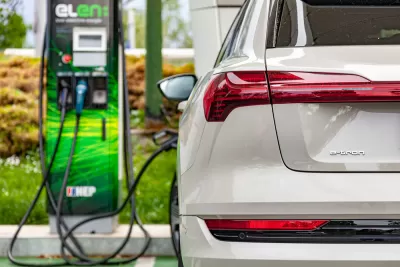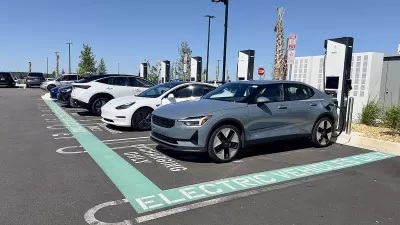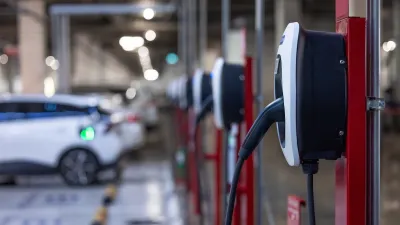The growing popularity of large, heavy SUVS—and the energy needed to produce and operate them—could limit the environmental gains made by electric vehicles.

Experts are warning that the larger size of personal vehicles—even electric ones—poses a risk to the environment, in addition to being more dangerous to pedestrians, writes Kea Wilson in Streetsblog. The warning comes from a European watchdog group, which Wilson points out is notable because cars sold in Europe are generally smaller than U.S. vehicles.
A report called the Green Car Assessment Program rates vehicles on their environmental impact, from manufacturing to tailpipe emissions and charging. “The researchers also controlled for the number of kilometers that vehicle was likely to be driven each year, and offered a free tool for motorists to estimate their cars' unique stats if they drive less than their countries' annual average, or if their vehicles weren't chosen for deeper analysis in this year's rankings.”
When taking into account all the ways a vehicle uses energy, ‘zero emission vehicles’ are, according to the study, “anything but — and large ones, especially, can have fewer environmental benefits than their green marketing campaigns might suggest. Overall, the electric vehicles in this year's dataset only cut between 40 and 50 percent of the greenhouse gas emissions compared to conventional petrol cars, rather than the 100 percent that the famous ZEV label implies.”
As Wilson explains, “any electric car on the road will be roughly 33 percent heavier than its gas-powered equivalent thanks to its heavy battery.” However, “the researchers stressed that Europe's nine percent increase in average vehicle weights on newly sold vehicles over the last ten years was also driven by another factor: the exploding popularity of large SUVs, whose sales increased sevenfold over that period.”
Ultimately, the researchers conclude that “the heavier the vehicle, the more harm it does to the environment and the extra energy required to drive the car.”
FULL STORY: Researchers Are Sounding the Alarm About Heavy EVs — Even in Europe, Where Cars Are Far Smaller

Planetizen Federal Action Tracker
A weekly monitor of how Trump’s orders and actions are impacting planners and planning in America.

Congressman Proposes Bill to Rename DC Metro “Trump Train”
The Make Autorail Great Again Act would withhold federal funding to the system until the Washington Metropolitan Area Transit Authority (WMATA), rebrands as the Washington Metropolitan Authority for Greater Access (WMAGA).

DARTSpace Platform Streamlines Dallas TOD Application Process
The Dallas transit agency hopes a shorter permitting timeline will boost transit-oriented development around rail stations.

Renters Now Outnumber Homeowners in Over 200 US Suburbs
High housing costs in city centers and the new-found flexibility offered by remote work are pushing more renters to suburban areas.

The Tiny, Adorable $7,000 Car Turning Japan Onto EVs
The single seat Mibot charges from a regular plug as quickly as an iPad, and is about half the price of an average EV.

Supreme Court Ruling in Pipeline Case Guts Federal Environmental Law
The decision limits the scope of a federal law that mandates extensive environmental impact reviews of energy, infrastructure, and transportation projects.
Urban Design for Planners 1: Software Tools
This six-course series explores essential urban design concepts using open source software and equips planners with the tools they need to participate fully in the urban design process.
Planning for Universal Design
Learn the tools for implementing Universal Design in planning regulations.
Roanoke Valley-Alleghany Regional Commission
City of Mt Shasta
City of Camden Redevelopment Agency
City of Astoria
Transportation Research & Education Center (TREC) at Portland State University
US High Speed Rail Association
City of Camden Redevelopment Agency
Municipality of Princeton (NJ)





























